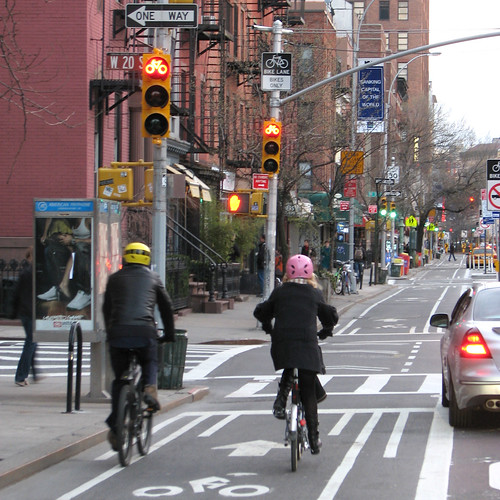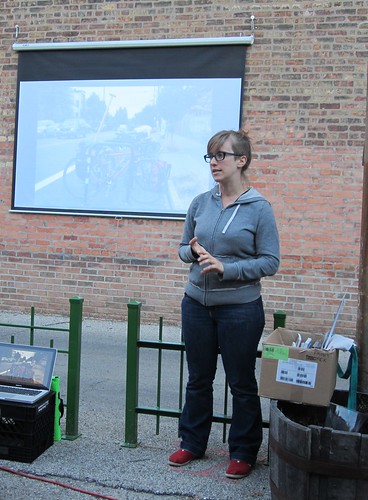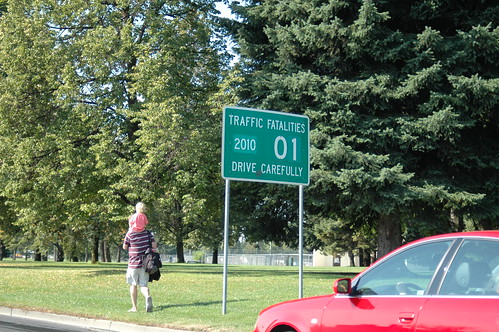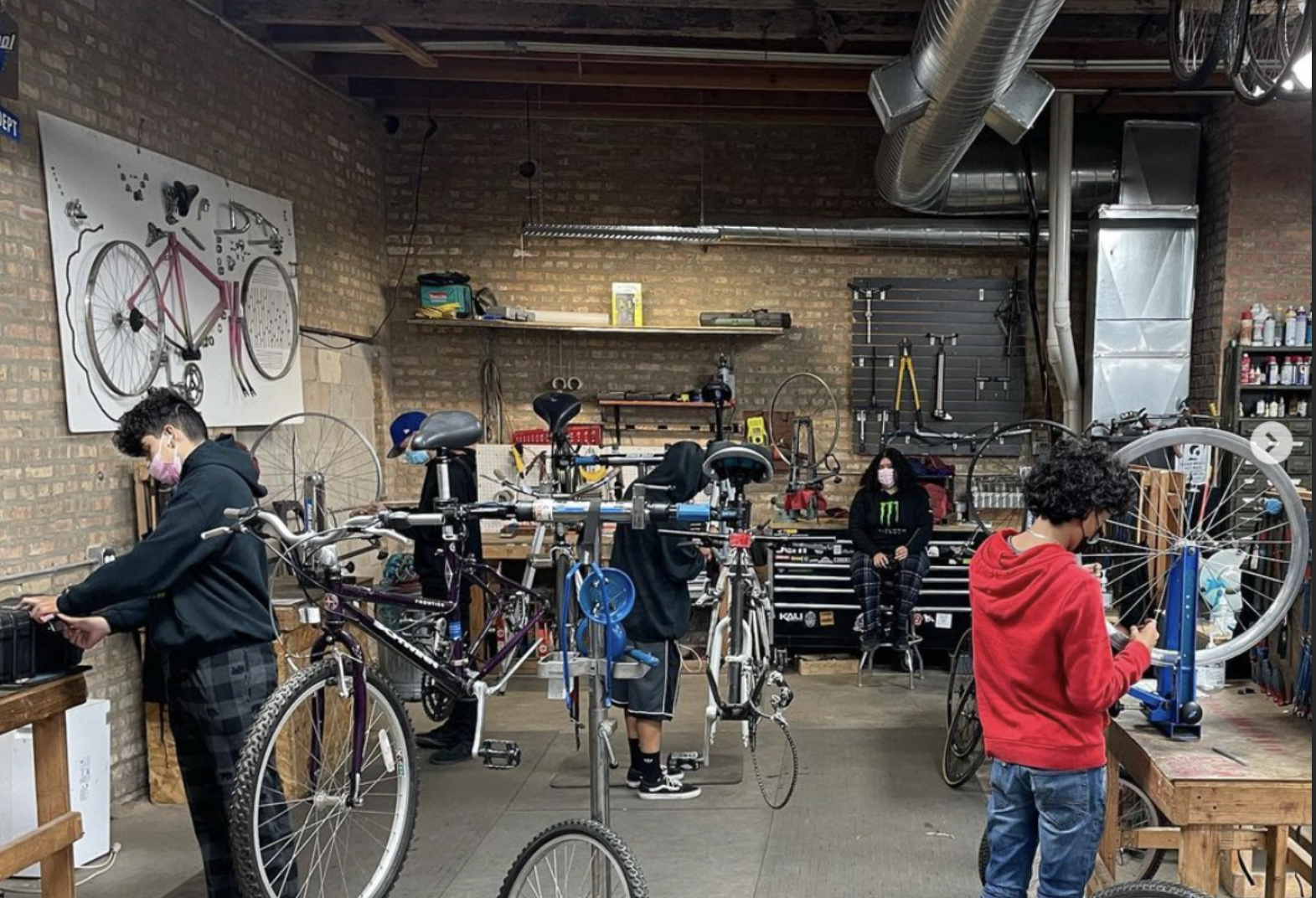Bike Writer Elly Blue Discusses the Economic Value of Safe Streets
11:08 AM CDT on June 6, 2013
On Monday, the month-long Dinner & Bikes tour, featuring bicycling author Elly Blue, writer and filmmaker Joe Biel, and vegan chef Joshua Ploeg, documented by Chicagoist contributor Aaron Cynic, made its final stop at Chicago’s Heritage Bicycles and Coffee. The event featured a vegan buffet prepared by Ploeg, a discussion of transportation planning and utility cycling by Blue, and a screening of Aftermass, Biel’s documentary about the history of bike planning, advocacy and activism in Portland, Oregon.
Based in Portland, Blue is the author of Everyday Bicycling: How to Ride a Bicycle for Transportation (Whatever Your Lifestyle). She is also the founder of Taking the Lane, a publishing company that puts out books about various aspects of cycling, and she writes an eponymous bike blog. Her second book, Bikenomics, about the financial benefits of bicycling, will come out in early 2014.
Here’s an excerpt from Blue’s presentation in which she discusses reasons why protected bike lanes are a must for cities that want to promote safety and prosperity; cycling’s safety-in-numbers phenomenon; and why you can’t put a price tag on human life.
Here’s another kind of infrastructure that we kinda can’t afford to not put in. [Shows slide of a protected bike lane.] This is a separated cycle track, one of a couple that we have in Portland. In case you don’t know what’s going on here, so there’s the sidewalk and then some trees, and then the bike lanes, and then there’s a little buffer zone and then those cars that you see, those are parked cars, and then after that is the street. And the parked cars protect you just as much as the sidewalk does, and it also is a way to keep people on bikes and people who are walking from conflicting with each other.
The first city that did these did them really well. In New York City on 8th and 9th avenues in Manhattan, they put in the first, real separated cycle tracks in the U.S. They did this in 2007 and they’re not perfect, they’re actually a little bit stressful to ride in but, in part, I think that’s what makes them work. Everyone has to pay attention. They studied them last year because they wanted to build more and they were getting a lot of community push-back.
So, since 2007 there’s been a recession, and business revenues in Manhattan have gone up on average three percent over that time, which is not very much. They found that revenues of local businesses on 8th and 9th Avenue since the cycle tracks went in went up almost 50 percent. Which means that businesses in Manhattan, local ones that do not have good, safe bicycle infrastructure, potentially lost out on 30 percent or more of their potential income during that time period. Really, this is how you create a thriving area.
The final economic concept I’d like to talk about is safety. We’re not really used to thinking of this as economic, but it strongly is. How many of you are under 35? If you’re raising your hand, sorry to tell you, but the way that you are most likely to die is in a car crash. If you’re 35 or over, that likelihood does not necessarily go down but other factors become more likely. Sorry, it is depressing.
We have in the U.S. what basically amounts to an epidemic of car crashes. There’s 30-40,000 people killed every year in traffic incidents and millions of people are injured, either temporarily or permanently disabled. When you think of about that from an economic perspective, this is huge. The basic unit of the economy really is us. It’s our labor, our work, our decisions, our buying and selling and our ability to take care of each other and be taken care of each other. And when you have any kind of major epidemic that hits all parts of society, though some less equally than others… [A motorcycle roars by.] I feel like that was the perfect timing for that motorcycle to go by.
Anyway, it has a huge, huge, huge impact on all levels, from the individual to social services to workforce to policing to everything. So you’d think that we’d be taking traffic safety seriously, and we have been. But, just like many other things, we’ve been doing it wrong.
[Shows a slide of a multi-lane road.] So this is a street in Spokane that was engineered to be safer and faster for people driving cars. It didn’t work. This is the way you go to the health food grocery store and many other stores and many other places where people live. It has no bike lanes, no sidewalks, etcetera. It’s very wide, about six lanes wide, and it’s signed for about 25 miles an hour, but people are smart. When people decide how fast to drive they’re not looking at the signs as much as we are assessing conditions around us, and this route has been widened, its curves have been smoothed out and, as you can see, the trees have been cut very far back from the road to increase sightlines, all in the name of safety.
[Shows a slide of a sign by the of the road that says “One traffic fatality / Drive carefully.”] There was clearly a traffic fatality on this stretch. This was in about August or September 2010. So their next line of defense in trying to make the road more safely was to put up this sign. And I would also like to point out they have room for double digits there, which is kind of depressing.
I don’t how much that sign cost, but I do know when any of us put a value on our lives, we would put an infinite monetary value on our lives. There’s no amount of money that any of us would trade for our own lives or for the lives of our loved ones. The federal government does put a monetary value on lives. They’re required to. Each agency must. The federal transportation department places that value at $7 million. If one life is removed from the economy, that’s what they estimate the worth at.
And they take that number into consideration in making decisions about traffic engineering. So this road, if they knew that putting in sidewalks would make it safer but it would cost more than $7 million and there was only one traffic death, then they cost-benefit analysis of that would be towards putting in sidewalks, it would be towards being like, OK, we’re breaking even for this year.
So that’s depressing. What’s less depressing is, once again bikes are pretty good for safety. So we were in Philadelphia two or three weeks ago. They told us that their bike counts have risen 100 percent every three years for the last decade. Pretty impressive. So you would think that the last number of injuries and crashes involving bicycles would go up at least 100 percent during that time or more, because when people first start riding bikes, they’re usually not very good at it. I know I wasn’t. I was a little reckless and I’m kind of amazed I survived.
But that doesn’t happen. Whenever you have more people riding bikes in an area the rate of crashes either stays flat as the number of cyclists increases, or it goes down. That’s a phenomenon called Safety in Numbers. It’s counterintuitive, and for that reason people keep studying it in cities around the world and keep finding it at neighborhood levels and at city levels. The more people who ride a bicycle, the safer the streets are for bikes.
And that’s not just true for bikes. That same study in New York City that found that separated cycle tracks make more money for businesses, they also looked at injury crashes before and after the cycle tracks went in and they found on 8th Avenue injuries to all road users, not just people on bikes but people driving and people walking, went down 35 percent, and on 9th Avenue injuries to all road users went down 58 percent. And in Philadelphia they found that too. They put in a cycle track and a year later [injuries to] all road users went down 45 percent. Again, we can’t afford not to do this on every level, not just financially.
In addition to editing Streetsblog Chicago, John writes about transportation and other topics for additional local publications. A Chicagoan since 1989, he enjoys exploring the city on foot, bike, bus, and 'L' train.
Stay in touch
Sign up for our free newsletter
More from Streetsblog Chicago
It’s electric! New Divvy stations will be able to charge docked e-bikes, scooters when they’re connected to the power grid
The new stations are supposed to be easier to use and more environmentally friendly than old-school stations.
Today’s Headlines for Tuesday, April 23
Communities United: Reports of Bikes N’ Roses’ death have been greatly exaggerated
According to the nonprofit shop's parent organization, BNR has paused its retail component, but is still doing after-school programming and looking for new staff.







